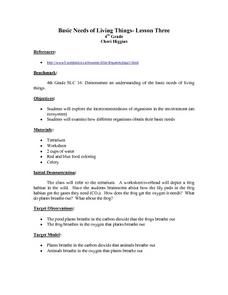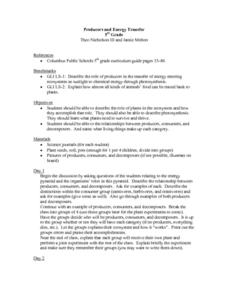Curated OER
The Art of the Puerto Rican People
Students study Taino Art and identify their crafts and stone carvings. They read the life of Campeche as presented and discuss with their teacher the economic and political situation of Puerto Rico in the eighteenth century and how...
Curated OER
Sense-sational
Learners investigate the five senses. They participate in the instructional activity for one week with each day devoted to one sense being sight, taste, sound, smell, and touch. They also cover the concept of being part of a global...
Curated OER
Weather
Second graders study the basic components of weather. They construct a thermometer and anemometer to measure temperatures, precipitation, and wind speed. In addition, 2nd graders discover how to find these components on weather maps.
Curated OER
Basic Needs of Living Things-Lesson Three
Fourth graders explore the interconnectedness of organisms in the environment and examine how different organisms obtain their basic needs. They discuss a frog's habitat and what is found in it. Students discuss the processes of...
Curated OER
Introduction to Nutrition
Fourth graders plan nutritional meals by using the USDA's Food Guide Pyramid and analyze food labels to aid in this planning. Using a slice of Wonderbread they discover what a calorie means, and that being active means burning up more...
Curated OER
The Food Pyramid
Fourth graders plan a variety of nutritional meals using the USDA's Food Guide Pyramid as a reference and analyze food labels to plan their meals. They examine and discuss the Food Pyramid, and create dichotomous keys separating food...
Curated OER
Reading Food Labels
Fourth graders examine the food labels on two similar items that are very different nutritionally such as a can of regular soda and a can of diet soda. Next they, sort through food labels to determine healthy and unhealthy foods by...
Curated OER
Recyclers to the Rescue
Fifth graders examine the concept of the food chain and define producer, consumer, herbivore, carnivore, and omnivore. They draw a food chain for a mouse and discuss the different organisms involved in the chain, and conduct an...
Curated OER
Recyclers Revisited
Fifth graders observe their plant experiments that they started in a previous lesson and examine the role of decomposers in the nitrogen cycle. Two weeks after they set up a worm terrarium, they analyze any changes they observe, and...
Curated OER
Pollution
Third graders investigate pollution. They discuss pollution and its effects. They create a Venn diagram of pollution and people polluting. They create a landfill and predict what will occur over a week's time. They create two air...
Curated OER
Effects Of Weathering
Third graders simulate weathering and erosion using sand and soil. They define weathering and the ways in which surfaces become weathered. Working as a class, 3rd graders complete various activities that demonstrate physical and...
Curated OER
Agents of Erosion
Fourth graders explore the agents of erosion. They observe rocks that are rough and unweathered and record observations. They investigate rocks rubbed with sandpaper and ones that are not and the effects that the sandpaper has on the...
Curated OER
Physical Changes and States of Matter
Fourth graders study evaporation and condensation as parts of the water cycle. First they determine the similarities and differences between a cup of water and an ice cube before measuring the volume of ice before melting it, and...
Curated OER
Simple Machines III - Pulleys
Fourth graders are introduced to a spring scale to show that the forces on both sides of the pulley are the same. They break into groups to lift objects with fixed pulleys and with multiple looped pulleys and then measure the force...
Curated OER
Simple Machines IV - Wheels and Axles
Fourth graders study everyday examples of simple machines. They examine how the combination of a wheel and axle works more efficiently than either in isolation. In a demonstration lesson, they see how a spring scale shows a force pulling...
Curated OER
Simple Machines I - Inclined Planes, Wedges, and Screws
Fourth graders examine the physics behind and uses for inclined planes, screws, and wedges. They determine examples of how these simple machines are used in daily life. Working in three small groups, they move from station to station...
Curated OER
Exploring Weather Websites
Students research and locate their own weather data using a weather website. They examine how to locate valid information on the www.weather.com website, and explore the website. Next, they select a city they want to visit, and compare...
Curated OER
Day and Night
Fifth graders investigate the Earth's rotation and revolution and the moon's orbit around the Earth. They participate in a class discussion about how night and day occur, and take notes. Next, they watch a video about the solar system...
Curated OER
Life Cycle
Third graders examine and compare the life cycles of a variety of different animals. They analyze photos of animals and discuss any unique body parts and why those parts function they way they do. Next, they observe mealworms and...
Curated OER
Food Webs and Chains
Fifth graders examine how simple food chains and food webs function. They examine an illustrated food chain/food web and identify the producers and consumers. Students then sequence pictures of animals into a food web, and create their...
Curated OER
Animal Classifications
Third graders work in small groups to investigate how to sort a variety of items into groups and subgroups. They work on a class chart based on the activity which show how the items are classified based on commonalities. Upon completion...
Curated OER
Classified Information - Part 1: Shapes
Third graders investigate how and why scientists use classification. They discuss classification strategies using animals, and as a class fill in a flowchart with their responses. Next, in small groups they cut out a variety of shapes...
Curated OER
Centrifugal Force and Mandy Sue Day
Fourth graders explore the story Mandy Sue Day and investigate centrifugal force. They demonstrate the concept of centrifugal force, use analytical thinking and they conduct an experiment using centrifugal force. Students discuss the...
Curated OER
Producers and Energy Transfer
Fifth graders discuss the relationship between producers, consumers, and decomposers as they look at the energy pyramid. While working in small groups, they create an ecosystem that includes all or some of the given categories, and they...
Other popular searches
- Christopher Columbus
- Columbus Day
- Kindergarten Columbus Day
- Columbus Day Elementary
- Columbus, Christopher
- Christopher Columbus Ships
- Columbus Day Art Project
- Libraries Columbus
- Columbus Day Activities
- Columbus Day Math
- Columbus Day Lesson Plans
- Christopher Columbus Song

























